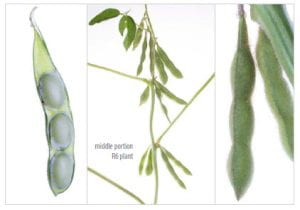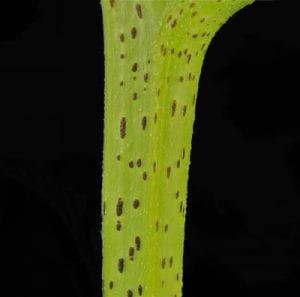
Sudden death syndrome (SDS) of soybean can be found in fields around the Midwest but still has limited distribution in Ohio. Yield losses associated with SDS in Ohio have been highly variable depending on the timing and severity of the initial infection, subsequent weather conditions, timing of defoliation, and the level of soybean cyst nematode (SCN) infestation in the field.
Symptoms and Signs – Foliar:

The first observed SDS symptoms are often early leaf symptoms, including yellow spots between leaf veins, known as interveinal chlorosis.

These lesions may expand and turn brown as the spots expand between veins, which is called interveinal necrosis. Leaf veins remain green. As the disease progresses, leaves die and prematurely fall from the plant, while petioles remain attached to the stem. Pods and seeds may be aborted.
Foliar symptoms of SDS can resemble those of many other diseases. These symptoms can occur in fields with high levels of inoculum as early as the vegetative stage, but most often occur near the middle pod-fill stages (R3-R4).
Symptoms and Signs – Roots & Stems:

Infected plants can have discolored and decaying roots even if there are no noticeable foliar symptoms of SDS. The woody tissue in the taproot can be brown to dark gray, while the upper portion of stem pith remains white.
Disease Cycle:
The fungus that causes SDS survives the winter in crop residue and soil. Early in the season, the fungus infects soybean roots, sometimes within a few days of seed germination. Infection is favored by cool, wet soil conditions. The SDS fungus produces toxins that plants transport through their water-conducting vessels (xylem) up to the leaves, which results in foliar symptoms. Typically, these symptoms occur after flowering, but they have been observed during early soybean growth stages on highly susceptible varieties or when conditions are favorable.
Conditions that Favor Disease: Cool, wet field conditions shortly after planting favor early root infections and disease establishment. Frequent or heavy rains midseason can favor early symptoms. Hot and/or dry conditions in the spring or summer can halt SDS development.
The presence of soybean cyst nematode (SCN) in the same field where SDS is found can increase the severity of SDS symptoms. Therefore, fields with SDS should be tested for the presence of SCN. Research has linked the presence of SCN with higher levels of SDS and increased yield loss. However, SDS can occur independently of SCN, and vice versa. Some crop production practices may also increase the risk of disease development. Fields with poor soil nutrients, low pH, poor drainage, or moderate to severe soil compaction are at higher risk of SDS.
Yield Loss and Impact: Yield losses due to SDS can be highly variable and depend on several factors, including the environment, the timing of symptom development, the susceptibility of a soybean variety to the disease, and the levels of SCN present in the field. SDS can weaken plants and cause premature defoliation — infected plants also may produce fewer and smaller seeds.
Yield losses can be substantial in years when susceptible soybean varieties are planted in cool, wet fields with a history of SDS and SCN. If symptoms develop later in the season, or weather is not conducive for disease development, yield losses can be minimal. Losses are rarely fieldwide since the disease often occurs in patches. If foliar symptoms appear at or after growth stage R6, yield loss may be minimal.
Management: SDS management strategies include planting soybean varieties with SDS resistance, managing SCN, using effective fungicide seed treatments, improving soil drainage in fields with recurring SDS, rotating crops, avoiding or reducing soil compaction, and maintaining proper pH and fertility levels.


 Most of the corn that I have seen this week is in either the R3 (Milk) or the R4 (Dough) growth stage. Some of our early maturing hybrids have reached the R5 dent stage.
Most of the corn that I have seen this week is in either the R3 (Milk) or the R4 (Dough) growth stage. Some of our early maturing hybrids have reached the R5 dent stage.
 Most of the corn that I have seen this week is in the R6 (Full Seed) growth stage. Some of the early maturity beans are entering the R7 (Beginning Maturity) stage soon.
Most of the corn that I have seen this week is in the R6 (Full Seed) growth stage. Some of the early maturity beans are entering the R7 (Beginning Maturity) stage soon.










 Stem: Mature stems are green, 1-4 ft. tall, highly branched, hairy, and flecked with maroon to black spots. Ridges are present on the stem. Upright hairs cause leaves to feel abrasive and gritty.
Stem: Mature stems are green, 1-4 ft. tall, highly branched, hairy, and flecked with maroon to black spots. Ridges are present on the stem. Upright hairs cause leaves to feel abrasive and gritty.
 Flower/Seedhead: Inconspicuous, greenish in color, arising from the area between the leaf petioles and the stems (axillary flowers) and at the ends of the erect stems (terminal flowers).
Flower/Seedhead: Inconspicuous, greenish in color, arising from the area between the leaf petioles and the stems (axillary flowers) and at the ends of the erect stems (terminal flowers).


 Disease pressure throughout the county continues to be very low. At this stage of growth, with little to no disease pressure, and new crop corn under $5 can we justify at least $25 per acre for a fungicide application?
Disease pressure throughout the county continues to be very low. At this stage of growth, with little to no disease pressure, and new crop corn under $5 can we justify at least $25 per acre for a fungicide application?

 It’s that time of year when weeds are beginning to show their ugly heads above the soybean canopy in many fields. During your scouting, if you find Palmer Amaranth or Waterhemp you should do whatever you can to prevent these devastating weeds from going to seed, including removing the entire plant from the field.
It’s that time of year when weeds are beginning to show their ugly heads above the soybean canopy in many fields. During your scouting, if you find Palmer Amaranth or Waterhemp you should do whatever you can to prevent these devastating weeds from going to seed, including removing the entire plant from the field.
 Pigweed has hair the others do not. Rub the stem and leaves checking for a “rough” texture. Palmer and waterhemp will be smooth.
Pigweed has hair the others do not. Rub the stem and leaves checking for a “rough” texture. Palmer and waterhemp will be smooth.
 the part of the plant that connects the leaf to the stem. The petiole on palmer plant is as long or longer than the leaf. Pigweed and waterhemp have much shorter petioles (often less than 1/2 the length of the leaf).
the part of the plant that connects the leaf to the stem. The petiole on palmer plant is as long or longer than the leaf. Pigweed and waterhemp have much shorter petioles (often less than 1/2 the length of the leaf).






 We are finding fields in Ohio affected by sudden death syndrome (SDS). These symptoms are showing up earlier than normal. SDS is caused by the fungal pathogen Fusarium virguliforme. This species is the most prevalent in the region, however, other Fusarium species can cause SDS.
We are finding fields in Ohio affected by sudden death syndrome (SDS). These symptoms are showing up earlier than normal. SDS is caused by the fungal pathogen Fusarium virguliforme. This species is the most prevalent in the region, however, other Fusarium species can cause SDS.







